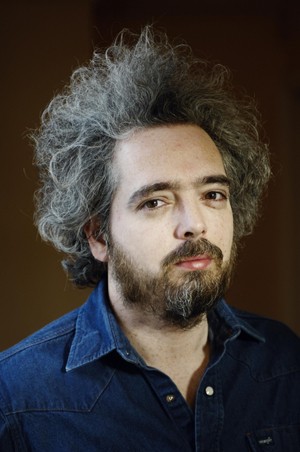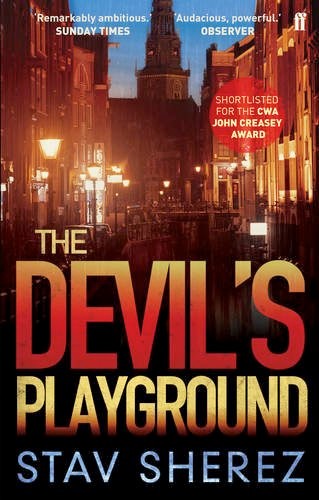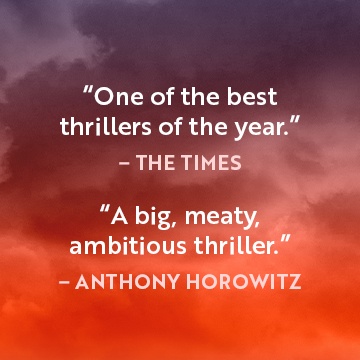 On 1 May 2014, Faber & Faber will be celebrating the anniversary of the arrival of a great new talent in British crime fiction. Yes, it’s 10 years since The Devil’s Playground by Stav Sherez first came out, and it’s being marked with a special 1oth Anniversary Edition. As an exclusive treat for Crime Fiction Lovers, Stav and his publishers have given us the postscript of this new edition – the author’s notes, if you like – to post on the site. You can read Stav’s recollections of how the book came about below.
On 1 May 2014, Faber & Faber will be celebrating the anniversary of the arrival of a great new talent in British crime fiction. Yes, it’s 10 years since The Devil’s Playground by Stav Sherez first came out, and it’s being marked with a special 1oth Anniversary Edition. As an exclusive treat for Crime Fiction Lovers, Stav and his publishers have given us the postscript of this new edition – the author’s notes, if you like – to post on the site. You can read Stav’s recollections of how the book came about below.
The Devil’s Playground introduced us to the author’s insightful style of crime writing. He skilfully weaves the horrors of past human conflicts into the lives of contemporary characters for a deeper, more poignant kind of storytelling. It’s dark stuff, for sure.
Set in Amsterdam, the novel begins with the discovery of a murdered tramp. Could he be the victim of a serial killer? If you haven’t read the book yet, now is the perfect time to acquaint yourself with Stav Sherez – and you’re unlikely to be disappointed. We’ll run our review of the 10th Anniversary Edition very soon here on Crime Fiction Lover.
In the meantime, it’s over to Stav Sherez for the book’s Postscript…
This is how it began. In a small room off Westbourne Grove. It was September 1999 and my 29th birthday had come and gone. Earlier that year I’d quit my job at the BBC to concentrate on writing. I had a vague idea of what I wanted to write about and a part-time job as a music critic allowed me to spend most of my time on the novel. I thought it would be easy. I thought it would be quick.
September was cold that year. My then partner was on a six-week trip to Japan. I was alone in the flat. I woke up every morning and stared at the blank screen. I went through my notes. I read books. I knew where the novel would be set. I didn’t know anything else.
That summer I’d been to Amsterdam for the first time since I was 17. I saw a different city now, a palimpsest of history and libertarianism populated by the ghosts of the receding century. I saw red and blue lights swirling against the cobblestones and canals. We were in the red-light district after all, but this was a very different kind of light. A crowd had gathered at the head of one of the narrow, window-studded alleys the city is so famous for. Two police cars and an ambulance blocked the other end. The red and blue lights strobed and sprayed against the glass. A body was stretchered out of one of the rooms, a white sheet covering its face.
Looking back on it now, this was where it began. The image stayed in my mind, nagged, shouted, and insisted I create a context for it.
Once I knew the novel would be set in Amsterdam, everything else followed. Landscape is both history and plot. I knew the book would have to deal with the city’s notorious libertarianism and issues of freedom. I knew the shadow of World War II would hang over every page. I couldn’t imagine writing a book about this city which didn’t address these things.
And then there was the tramp.
He stood outside the cashpoint, opposite the high windows of my small room. He was there every day, regardless of the weather. He never asked for money or held up a sign or paper cup. He looked distinguished, out of place; his bearing, the way he held himself, his long white hair and beard. He always carried a pile of books with him. He was always barefoot.
I would look out the window that autumn and see him standing there. I was stuck in a room with the blinking cursor, the empty screen. I looked out the window a lot those days. And I began to invent his life. I made up stories, speculated, guessed and conjectured, but I never asked him. We would exchange a few brief words in the morning when I left my room for coffee, but that was it.
I thought about letting him stay in the flat but I didn’t think about it for long. I was living in a tiny space with my girlfriend and all our accumulated possessions, mountain ranges of books and music. We had been together for seven years, but lately something in our hearts had started to drift. We didn’t realise it at the time, but we’d begun to cancel each other out. The flat was composed of areas, demarcated and rarely kept to.
I had a million other rationalisations for not inviting the man in and letting him stay. So instead I did what writers do I posited that essential what if? question and the answer was The Devil’s Playground.
It was not an easy book to write in all the ways that books aren’t easy to write. I had only written one novel before, The Great American Desert, a story about an English couple who go to LA for their honeymoon. They rent a car at the airport and immediately get lost. They are carjacked and the woman is shot dead. The man, in a state of shock, drives. He has no idea where or why. He ends up in the south-western desert, befriends a contract killer, and together they go searching for a legendary astronaut turned mystic televangelist. It taught me how not to write a book. Every sentence you write teaches you what is wrong with it.
I stared endlessly at the blank page. I knew what I wanted to write about, the landscape and themes I wanted to pursue, but it took me a long time to find the right medium for them. And, even after I’d finished the book, I still didn’t realise that what I’d written was a crime novel.
Ian Rankin says he was an accidental crime writer and that’s a phrase I like a lot. My literary heroes were William Burroughs, Thomas Pynchon, Cormac McCarthy. But they were also James Crumley, Jim Thompson and James Ellroy. I loved the dense figurative language and ideas of the former group and I dug the adrenaline-pumping plots and recon- figured histories of the latter.
 But this is all hindsight. When I started writing The Devil’s Playground, I wasn’t thinking of genre, I was only wondering what would be the best way to tell this story. That’s the beauty and heartbreak of your first published novel. As a writer you’ll never write anything like that again. The first novel exists in a place of uncertainty, before you have an audience, before readership expectations, before you realise your own limitations. You try and cram everything you know between their pages. They are the sum product of all the years leading up to them, while every novel that follows is structured by time and the constant swerve against diminishing returns.
But this is all hindsight. When I started writing The Devil’s Playground, I wasn’t thinking of genre, I was only wondering what would be the best way to tell this story. That’s the beauty and heartbreak of your first published novel. As a writer you’ll never write anything like that again. The first novel exists in a place of uncertainty, before you have an audience, before readership expectations, before you realise your own limitations. You try and cram everything you know between their pages. They are the sum product of all the years leading up to them, while every novel that follows is structured by time and the constant swerve against diminishing returns.
So I began, as I always do, without a plan. I knew what I wanted to talk about but not how. I knew the novel would have at least eight POV characters and I started telling their stories. The months passed, my partner came back, the old man disappeared from the street, as if he’d served his purpose. The characters in the draft told their stories. The stories began to revolve around similar themes: violence – its justifications and representations. This was the central gravitational field that pulled all the disparate ends together. But without a plot this meant nothing. As draft followed draft, the story began to creep in, and a detective made his presence felt.
I can’t remember how many drafts I wrote for The Devil’s Playground but it’s in the ballpark of 20. I still do 10 drafts when I’m writing a novel nowadays. Each draft layers a different part of the story into the text, each draft weeds out clichés and gets you closer to the right word, the perfect shocking twist. The draft went through many changes. I still have 200 pages of extra material that I cut for reasons of pace. The title changed too. It started as Holocaust Studies, then turned into Inheritance, then became Rain Dogs, which finally mutated into The Devil’s Playground.
The process towards publication was not an easy one. It very rarely is. I had approximately 40 rejection letters from agents. I worked on the manuscript with two agents before I found the right one. I almost threw her letter away. It looked like a form rejection, but I opened it. She liked the book and sent it out to editors. If it wasn’t for Lesley Thorne, I would probably have abandoned the novel. I remember a Friday afternoon, sitting at home, watching Fellini’s 81⁄2 when the phone rang. She told me Penguin had made an offer on the book. I looked at the mute monochrome face of Marcello Mastroianni and tried to remember how to breathe.
The novel came out and got better reviews than I could ever have hoped for. It was shortlisted for the CWA John Creasey Dagger.
I thought this was it. I thought my career and life were on the right track. But this was only the beginning. There were many more endings first and it was five years before my next novel, The Black Monastery, was published. I was living in a different flat by then, with a different woman, and contracted to a different publisher.
Sometimes you have to go through the wrong door to get to the right room. Faber felt like the right room. My editor, Angus Cargill, understood what I was trying to do and knew how to make it better. He always liked this novel. It’s because of his tireless advocacy that it’s now in your hands.
I haven’t re-read it. I’ve never re-read any of my books once they’ve gone into print. It’s like watching scratchy home movies, that curious split between acute embarrassment at your own youth and a nostalgia for the fire and flare of those days. I hope the novel stands up. I hope readers of my later books will find something to like here. It’s not the easiest book to read, but the subject matter meant I couldn’t take any shortcuts. It’s also the book where all the music crammed into my head was finally put to use. I inserted songs wherever I could. People complained the songs were obscure but nowadays you can easily look them up online. In my subsequent books there are very few music references. If I’ve done something in one book, I don’t like to repeat. But, in the chapter I wrote today, Jack Carrigan bought his first CD in a long time and was about to put it on. The themes explored in The Devil’s Playground ricochet through all my subsequent novels and I have no doubt they will continue to do so across the ones to come.
Stav Sherez, November 2013
Read our reviews of A Dark Redemption and Eleven Days. Also see Stav Sherez’s top 10 crime novels in disguise.








